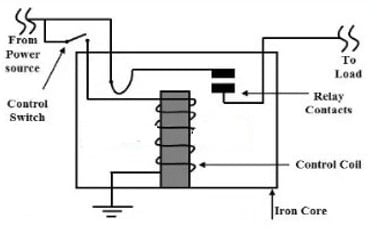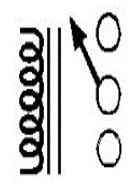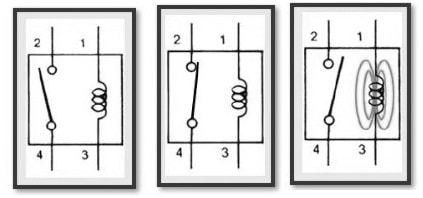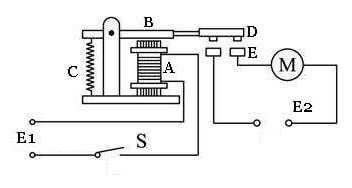A relay is an electrically operated switch that either opens or closes an electrical circuit. Generally, Relays have an induction mechanism at the input part that reflects certain input variables like; voltage, current, power, frequency, impedance, temperature, speed, pressure, etc. It has an actuator at the output part that can understand the ON & OFF control of the controlled circuit. There is an intermediate mechanism between the input & output parts of the relay, known as the drive part used for coupling & isolating the input, functional processing & driving the o/p part. Relays are generally found in nearly any machine that includes an electrical system. These are used for controlling high voltage & high current devices. There are different types of relays available. This article provides brief information on one of the types of relay namely electromagnetic relay.
What is an Electromagnetic Relay?
A relay that works on the electromagnetic attraction principle is called an electromagnetic relay. It is a magnetic switch that utilizes the magnet to create a magnetic field. After that, this magnetic field is used to open & close the switch to perform the mechanical operation. Electromagnetic relay works similarly to a contactor although it has a smaller range of amperes as compared to a contactor. It controls the large amount of load current with quite small power like; 24 DC V (or) 230 AC V up to 5Amps.
These relays have two contacts for normally open & normally closed operations. This relay is typically used to control many electrical circuits. These relays are available in both AC and DC types and available in 5, 8 & 14 pin configurations.
Electromagnetic Relay Construction
Electromagnetic relay is designed with three significant components; an Electromagnetic coil, a Movable Armature & two contacts; NO & NC.
The two relay contacts are simply constructed with low-resistance metals as well as alloys to keep away from overheating. In addition, the metal utilized to build the contacts should be capable of resisting both the welding process that occurs whenever the contacts close & the arcing develops whenever the contacts open. The metals that are used to make relay contacts are; Silver, Certain Alloys, Tungsten, and Palladium.
An electromagnetic coil in this relay is formed by simply winding a copper wire or coil in the helix (or) a circle form. Whenever the terminals of the electromagnetic coil get the supply, then it supplies quickly throughout the copper wires and starts to generate a magnetic field because the magnet is created only when the electric current supplies throughout the coil. There are two different contacts available in this relay; Normal open & normal closed to make up two connections.

Construction
Electromagnetic Relay Working
Electromagnetic relays generally work based on the electromagnet. This relay has two operating conditions; NO condition & NC condition which are discussed below.
In a normal open condition, the contacts of the relay are open, so the electromagnetic coil cannot be energized. When the current supply gets toward the electromagnetic coil, it starts generating a magnetic field. The movable armature is drawn in the direction of the coil through this magnetic field. The circuit closes whenever the common contact approaches into contact with the NO contact. So in this way, supply moves from the common terminal to the normally open contact.

NO Condition
In normally closed conditions, the two contacts will be closed so the electromagnetic coil will not energized. Once it energizes, then contact will open to break the circuit & avoid the supply flow. The movable armature will touch the upper contact whenever the contact is normally closed.
When the external circuit is connected between two terminals 1 & 2 then it will be in the open position, whereas any external circuit is connected in between two terminals 1 & 3 then it will be in a closed position.

NC Condition
The armature can be drawn in the direction of the coil whenever the voltage is provided to it, then it activates the relay to form a magnetic field nearby it. Any external circuit connected between 1 & 2 terminals is complete now.
Electromagnetic Relay Circuit
An electromagnetic relay circuit is shown below. The significant components of this relay are electromagnet ‘A’, spring ‘C’, armature ‘B’, static contact ‘E’, and moving contact ‘D’, which is shown in the following figure. This circuit is used to control the motor.
This circuit working can be separated into two main parts; a low-voltage control circuit & high-voltage working circuit. So, the low-voltage control circuit has an electromagnetic relay coil, low-voltage power supply (E1), switch (S). Similarly, a high-voltage working circuit has a high-voltage power supply (E2), motor (M), electromagnetic contact (D) & E parts of the relay.

Electromagnetic Relay Circuit
Working
The working of this circuit is; when the switch ‘S’ is closed within the low-voltage control circuit, then current starts flowing throughout the electromagnet ‘A’ coil to generate a magnetic field, thus producing gravitational energy on the armature (B), making the static & moving contacts E & D, the circuit is closed & the motor starts working; Once the low-voltage switch ‘S’ is turned off, then flow of current within the coil will vanish. The armature ‘B’ under the spring C action separates the static and moving contacts D and E, the working circuit will be disconnected & the motor will stop working.
If a certain voltage is provided to both the coil ends, then a certain current will supply within the coil and it produces electromagnetic effects. In the electromagnetic force action, the armature will conquer the pull power of the return spring & attract it to the core to drive the armature.
After that, the static contact & the moving contacts are pulled together. Once the coil is turned off, then electromagnetic attraction also vanishes, and the armature returns to its original position in the reaction power of the spring by releasing the moving & static contacts to attain the purpose of conducting & cutting off within the circuit.
The electromagnetic relay’s NO & NC contacts can be differentiated as follows: the static contact is in the off condition whenever the electromagnetic relay coil is not energized which is known as NO contact. The static contact that is within the on-state is known as NC contact.
Electromagnetic Relay Types
These relays are classified into two types based on the working principle; electromagnetic attraction relay & electromagnetic induction relay which are discussed below.
Electromagnetic Attraction Relay
This is a very simple type of electromagnetic that works on the electromagnetic attraction principle. In this relay, a coil is wounded on the armature that works as an electromagnet. The flow of current in normal operating conditions is small & is not enough to generate a strong magnetic field & not attract the plunger. Thus tripping contacts will stay in open conditions & the breaker cannot be tripped. Whenever a fault takes place within the power system, then more operating current supplies throughout the coil & a strong magnetic field can be generated by the magnet. This relay uses two types of structures like balanced beam relay and a hinged armature relay.
Electromagnetic Induction Relay
This relay works similar to an induction motor including split phases. The initial force is formed on the moving element of this relay which might be a disc (or) another kind of rotor of the non-magnetic moving element. To create the force, an eddy current is induced within the rotor through the electromagnetic fluxes by interacting with the fluxes. There are different kinds of structures have been utilized for determining the phase difference within the fluxes like shaded pole structure, watt-hour meter structure, and induction cup relay.
Advantages & Disadvantages
The advantages of electromagnetic relay include the following.
- Electromechanical relays are simple types of relays with reliability, durability & less cost.
- These relays operate very quickly.
- These types of relays can be applied to both AC & DC systems to defend AC & DC equipment.
- Electromagnetic relays are small, sturdy, simple & most trustworthy.
- These relays are almost instantaneous.
- The operating time of this relay changes based on the current.with extra arrangements like copper rings, dashpots, and many more.
The disadvantages of electromagnetic relays include the following.
- To operate these relays, high-burden range instrument transformers are needed like; PTs & CTs.
- Pollution, aging & Dust will have an impact on the electromagnetic relay operation, so it results in incorrect trips.
- In this relay, there is no directional feature.
- This relays mechanical inertia component sets a speed limit on operation.
- It needs routine maintenance & testing.
Applications
The applications of electromagnetic relay include the following.
- Electromagnetic relays help protect various AC & DC instruments.
- It is used to protect different AC & DC equipment from under or over voltage & current.
- These can be used as supplementary relays within contact systems of protective relay schemes.
- These are used for differential protection.
- Electromagnetic relay is used in automobiles for Fuel pumps, starter motors, horns, windshield wipers, etc.
- These are used in building automation for access control systems, control panels & elevators.
- These relays are used in Industrial automation for motor controllers, light controllers, distribution of power supply & switching.
- Used in domestic electric appliances like washing machines, Ovens, indoor or outdoor AC units, etc.
- Electromagnetic relays are used frequently in control circuits to switch on and off electrical signals in reply to a control signal.
- These relays are used in protection circuits to interrupt the electricity flow when over-current (or) different fault conditions occur.
- Electromagnetic relays are used for amplifying electrical signals by switching on & off rapidly in radio & other types of communication systems.
- These are utilized in timing circuits to switch on & off circuits at particular intervals like street lights timing controlling (or) other electrical devices.
Please refer to this link for Electromagnetic Relay MCQs.
Why electromagnetic relay is used?
An electromagnetic relay is a component that controls electrical circuits with an electrical signal. These are mainly used where it is essential to control single or more circuits through a single electrical supply circuit. So the electrical supply may or may not be separated from the relay circuit.
How electromagnetism is used in the relay?
Electromagnetism is used to activate a movable metal strip known as an armature. The armature movement can cause the relay contacts to either close or open, thus turning an electrical circuit ON/OFF.
What is an electromagnetic induction relay?
Electromagnetic induction relay is the most extensively used relay which operates on the split-phase induction motor principle.
Thus, this is an overview of an electromagnetic relay, construction, its working, types, advantages, disadvantages, and applications. This is a switch operated electrically, used for controlling an electrical circuit through an electromagnetic mechanism. This relay includes a wire coil, a movable armature & sets of contacts. These relays are used commonly within control systems & electrical circuits to amplify, isolate, and switch electrical signals. Here is a question for you, what is a relay?